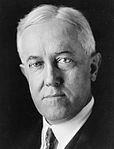
Back انتخابات الرئاسة الأمريكية 1924 Arabic ھەڵبژاردنی سەرۆکایەتیی ویلایەتە یەکگرتووەکانی ئەمریکا (١٩٢٤) CKB Præsidentvalget i USA 1924 Danish Präsidentschaftswahl in den Vereinigten Staaten 1924 German Elecciones presidenciales de Estados Unidos de 1924 Spanish انتخابات ریاستجمهوری ایالات متحده آمریکا (۱۹۲۴) Persian Yhdysvaltain presidentinvaalit 1924 Finnish Élection présidentielle américaine de 1924 French הבחירות לנשיאות ארצות הברית 1924 HE ԱՄՆ նախագահական ընտրություններ 1924 Armenian
This article includes a list of general references, but it lacks sufficient corresponding inline citations. (January 2021) |
| |||||||||||||||||||||||||||||||||||||||||
531 members of the Electoral College 266 electoral votes needed to win | |||||||||||||||||||||||||||||||||||||||||
|---|---|---|---|---|---|---|---|---|---|---|---|---|---|---|---|---|---|---|---|---|---|---|---|---|---|---|---|---|---|---|---|---|---|---|---|---|---|---|---|---|---|
| Turnout | 48.9%[1] | ||||||||||||||||||||||||||||||||||||||||
| |||||||||||||||||||||||||||||||||||||||||
 Presidential election results map. Red denotes states won by Coolidge/Dawes, blue denotes those won by Davis/Bryan, light green denotes Wisconsin, the state won by La Follette/Wheeler. Numbers indicate the number of electoral votes allotted to each state. | |||||||||||||||||||||||||||||||||||||||||
| |||||||||||||||||||||||||||||||||||||||||
Presidential elections were held in the United States on November 4, 1924. Incumbent Republican President Calvin Coolidge won election to a full term. Coolidge was the second vice president, after Theodore Roosevelt, to ascend to the presidency and then win a full term.
Coolidge had been vice president under Warren G. Harding and became president in 1923 upon Harding's unexpected death. Coolidge was given credit for a booming economy at home and no visible crises abroad, and he faced little opposition at the 1924 Republican National Convention. The Democratic Party nominated former Congressman and ambassador to the United Kingdom John W. Davis of West Virginia. Davis, a compromise candidate, triumphed on the 103rd ballot of the 1924 Democratic National Convention after a deadlock between supporters of William Gibbs McAdoo and Al Smith. Dissatisfied by the conservatism of both major party candidates, the newly formed Progressive Party nominated Senator Robert La Follette of Wisconsin.
In a 2012 book, Garland S. Tucker argues that the election marked the "high tide of American conservatism", as both major candidates campaigned for limited government, reduced taxes, and less regulation.[2] By contrast, La Follette called for the gradual nationalization of the railroads and increased taxes on the wealthy, policies that foreshadowed the New Deal.
Coolidge won a landslide victory, taking majorities in both the popular vote and the Electoral College and winning almost every state outside of the Solid South (while still making headway by winning Kentucky). La Follette won 16.6% of the popular vote, a strong showing for a third-party candidate, while Davis won the lowest share of the popular vote of any Democratic nominee in history. This was one of only three elections with more than two major candidates where any candidate received a majority of popular votes cast, the others being 1832 and 1980. This is the most recent election to date in which a third-party candidate won a non-Southern state. This was also the US election with the lowest per capita voter turnout since records were kept.[3] This election was the last time the Democratic nominee for vice president was a sitting governor until 2024. It was also the last time a Republican won the presidency without winning any of the former Confederate states. It was the only election between 1868 and 1952 that none of the major party nominees had there home state from either New York or ohio.
- ^ "National General Election VEP Turnout Rates, 1789-Present". United States Election Project. CQ Press.
- ^ Garland S. Tucker III, The High Tide of American Conservatism: Davis, Coolidge and the 1924 Election (Emerald, 2010)
- ^ "Voter Turnout in Presidential Elections | The American Presidency Project". www.presidency.ucsb.edu. Retrieved December 8, 2020.
Cite error: There are <ref group=lower-alpha> tags or {{efn}} templates on this page, but the references will not show without a {{reflist|group=lower-alpha}} template or {{notelist}} template (see the help page).


